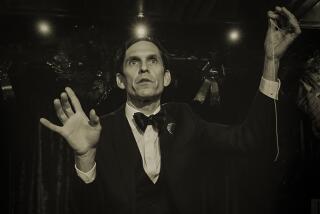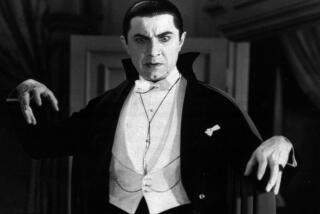The Publisher As Provocateur
- Share via
In 1987, Adam Parfrey compiled, edited and co-published a collection of essays, interviews and art about and by UFO and religious cults, serial murderers, conspiracy kooks, and body-modification and piercing fetishists that seemed to presage the extreme cultural obsessions of what would come to be called Generation X.
The brisk sales of the book, “Apocalypse Culture,” raised interesting questions about the cultural value of the deliberately provocative material. Since then, Parfrey’s imprint, Feral House, has published dozens of titles, including several volumes of Church of Satan founder Anton Szandor LaVey, coroner photographs, a history of sexuality in the Weimar Republic and “Nightmare of Ecstasy: The Life and Art of Edward D. Wood, Jr.,” which was adapted into the Tim Burton film “Ed Wood.” Parfrey recently released “Apocalypse Culture II,” containing works by Ted Kaczynski, an interview with the president and sole member of Jews for Hitler and other offensive, humorous or thought-provoking dispatches from the fringes of consensual reality.
Herewith, the 43-year-old L.A. native answers for what he has wrought.
*
Q. Why do you name these phenomena the Apocalypse Culture?
A. This is the culture engendered by the millennial/apocalypse fantasy in Western culture. What’s weird is that the mainstream newspapers now cover this as everyday material, but in 1987, it was so freaky and far out. Extreme art, called aesthetic terrorism, all of a sudden became cool.
*
Q. How did the idea for Apocalypse Culture start?
A. Around 1984 I started “The Journal of Unpopular Views.” I didn’t know it would become “Apocalypse Culture.” It was just what seemed to be extreme, outrageous behavior that piqued my curiosity. For instance, I sent away for the most sickening, monstrous propaganda that there was. Extreme right-wing groups would send me this stuff from the ‘30s, and I wondered, “What is this thing, eugenics?” So I looked it up and I found out that [early in the century], California passed laws to sterilize the mentally and physically unfit, and these laws were a big influence on Hitler.
*
Q. What’s the point of dredging up all this taboo material?
A. Upsetting people is a beautiful thing. Because it gets people to think beyond their last visit to 7-Eleven. There’s a lot about this world to be upset about. And an influence in that whole thing is epic theater, like the theater of Bertolt Brecht, about confronting audiences with realities outside the dotted line of Judeo-Christian acceptability. Maybe it gets people angry, but it gets people thinking.
*
Q. The millennium has come and gone. Why did you put the second volume together?
A. The year 2000 is a far different world in which people confront different taboos. What is the difference between the Unabomber murdering three people with bombs to call attention to environmental homicide by huge corporate interests and going to Iraq and murdering people and getting applauded? The difference is hypocrisy, the things you can say in public and the things that are considered verboten.
(BEGIN TEXT OF INFOBOX / INFOGRAPHIC)
PARFREY’S FAVORITES
*The Milton Bradley game Conspiracy: A spy game of bluffing and betrayal!
*A framed image of a bleeding, weeping Christ done in raised lacquered wood with the word perdonalos! (“Forgive them!”)
*Movie poster for “The Black Gestapo,” a 1975 blaxploitation film
*Allied propaganda poster of a swastika’d-sleeved hand thrusting a dagger through a Bible and the caption “This Is the Enemy”
*Dream Machine (a Timothy Leary-era invention said to induce altered states)
*1970s pharmaceutical pill counter
*Box of African American biblical action figures
*Various nasal snuff containers imported from England
*1940s wrestling photos and admission tickets
*Treasury Department order form for cocaine, opium and morphine (required by pharmacies at the time) dated April 8, 1924
*Framed illustration of a montage of deviant sexual acts culled from a 1930s Sexology magazine
*
Parfrey will promote his book, “Apocalypse Culture II,” at Book Soup on Oct. 24.
More to Read
Sign up for our Book Club newsletter
Get the latest news, events and more from the Los Angeles Times Book Club, and help us get L.A. reading and talking.
You may occasionally receive promotional content from the Los Angeles Times.







